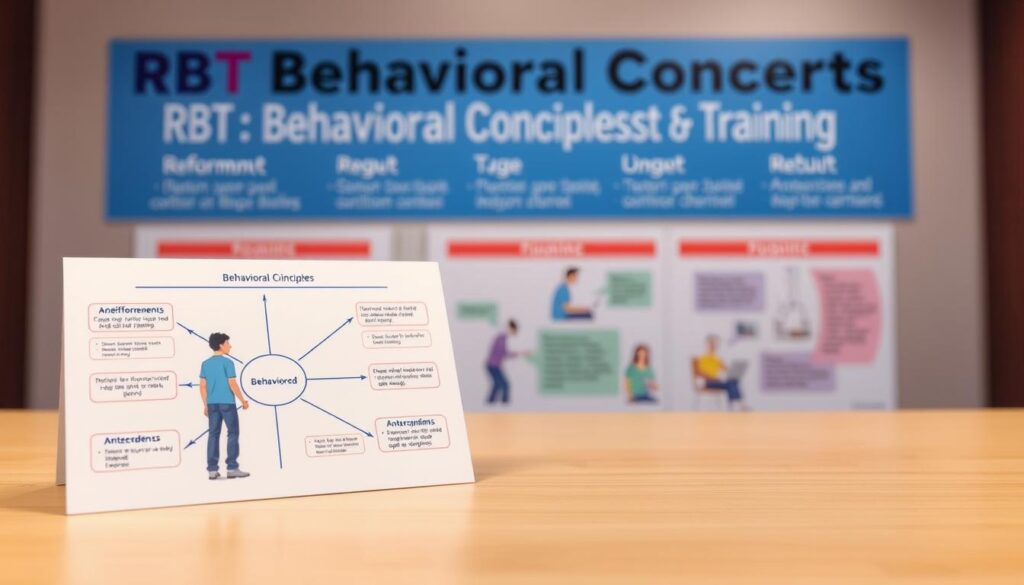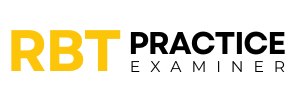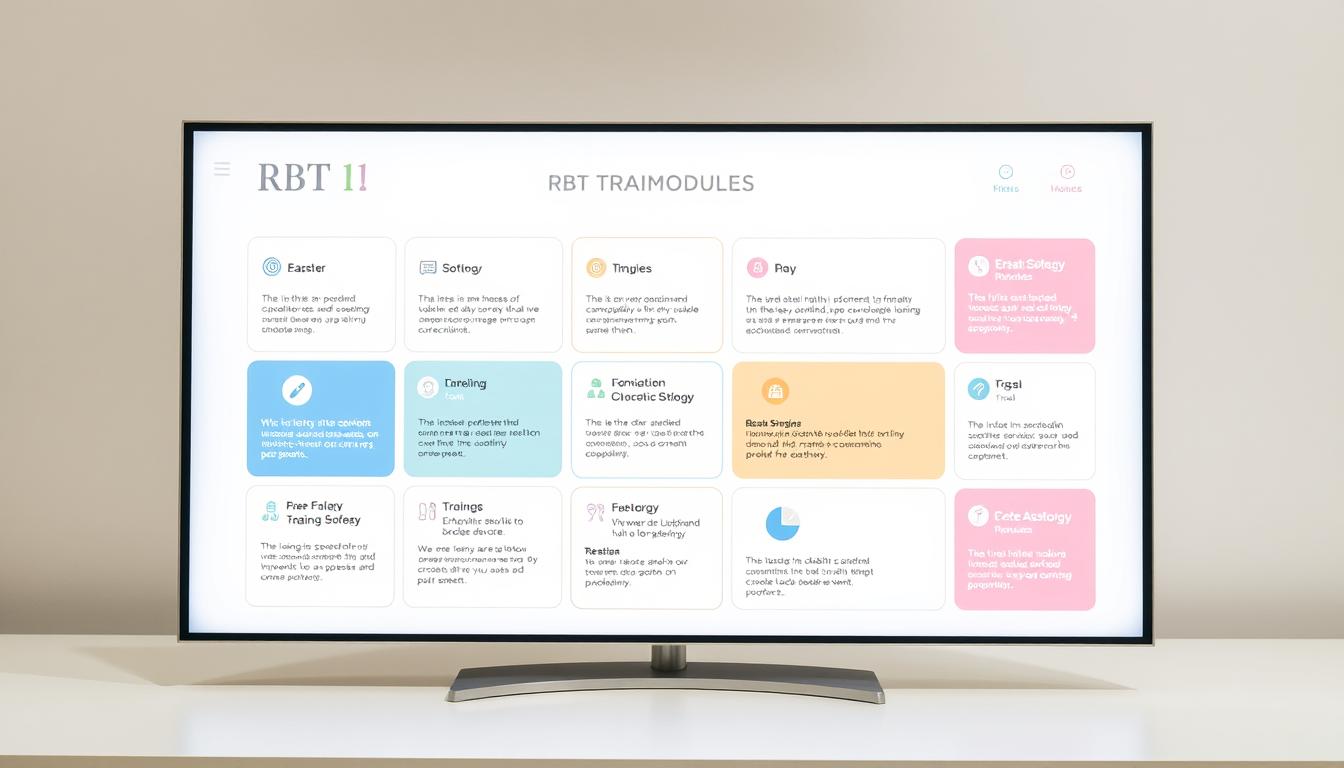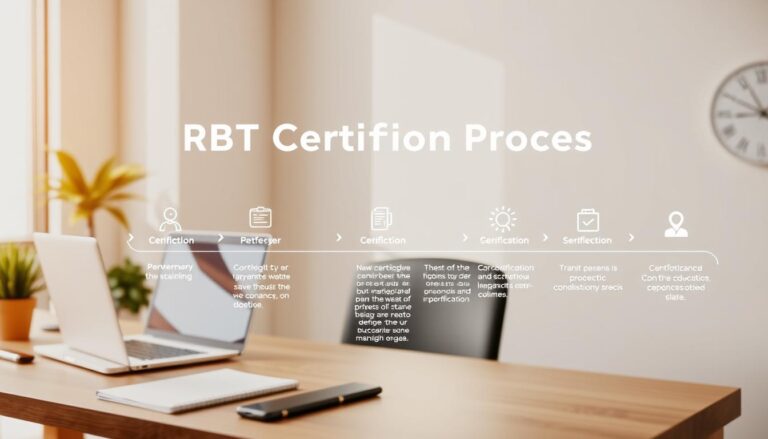How Many Modules Are in RBT Training?
Registered Behavior Technician (RBT) training is a detailed way to learn key skills. It helps professionals support people with autism and developmental disabilities. If you want to know how many modules are in RBT training, you’ll find a clear path to get certified.
RBT modules give deep training in applied behavior analysis. They cover important areas of work, making sure candidates can offer top-notch behavioral services.
The Behavior Analyst Certification Board (BACB) sets rules for RBT modules. Those wanting to become technicians go through a series of training parts. This prepares them for the job and certification.
Important parts of RBT training include learning about behavior, how to assess, and making intervention plans. These modules give professionals the tools to help people well.
The training program is both theoretical and practical. It’s structured in modules to make sure you understand how to help and what your job is.
Understanding RBT Training Fundamentals
Registered Behavior Technician (RBT) training is key for those wanting to help people with autism and behavioral issues. It teaches essential skills in applied behavior analysis through a structured program.
Those aiming to become RBTs must go through a detailed certification process. This training gives them the skills to make a real difference in behavioral interventions.
Core Components of RBT Certification
The RBT certification process includes several important parts:
- 40-hour training course on basic behavioral principles
- Deep understanding of ethical rules
- Supervised hands-on experience
- Passing a competency test
- Background check and verification
Prerequisites for Starting RBT Training
To start RBT training, you need to meet certain criteria:
- Be at least 18 years old
- Have a high school diploma or similar
- Pass a criminal background check
- Finish the initial training needs
Training Duration and Time Commitment
The RBT training requires a big but doable time investment. Most people finish the initial certification in 2-3 months. This depends on how fast you learn and how much supervision you get.
Expect to spend about 40-60 hours on initial training. This includes coursework, supervised practice, and getting ready for the final test.
How Many Modules in RBT Training: A Complete Breakdown
Understanding the rbt course structure is key for those wanting to be Registered Behavior Technicians. The training covers a wide range of topics. It prepares professionals to work with people with autism and other behavioral issues.
The RBT training program has several important modules. These modules are designed to give a solid base in behavioral intervention techniques. They are made to ensure you’re well-prepared for your job.
- Basic Skills Module
- Ethical Considerations Module
- Assessment and Measurement Module
- Intervention Strategies Module
- Documentation and Reporting Module
While training providers may vary, most follow a similar structure. The main goal is always the same: to fully prepare you for behavioral intervention work.
| Module Name | Primary Focus | Typical Duration |
|---|---|---|
| Foundational Skills | Basic behavioral principles | 10-15 hours |
| Ethical Practice | Professional conduct and client rights | 4-6 hours |
| Intervention Techniques | Practical behavior modification strategies | 15-20 hours |
| Documentation | Reporting and record-keeping | 5-8 hours |
Aspiring RBTs should know that the curriculum might differ slightly between programs. The important thing is to make sure you get all the essential skills and knowledge needed for effective behavioral intervention.
The RBT Task List and Module Structure
Registered Behavior Technician (RBT) training covers key skills for helping others. It has a detailed plan to teach professionals how to help with autism. This training is all about learning how to help others.
The RBT training topics are set up to help you understand your job well. The task list is like a map. It shows you how to get good at analyzing behavior.
Measurement and Assessment Tasks
Learning to measure behavior is very important in RBT training. You will learn how to collect data carefully through special lessons:
- Direct observation methods
- Frequency and duration recording
- Interval recording techniques
- Graphing and visual representation of behavioral data
Behavior Reduction Procedures
Knowing how to reduce bad behavior is key in RBT training. You will learn many ways to handle tough behaviors:
- Functional behavior assessment principles
- Antecedent manipulation strategies
- Replacement behavior development
- Positive reinforcement techniques
Documentation and Reporting Requirements
Being good at writing reports is a big part of being an RBT. The training focuses on how to write reports clearly:
| Documentation Area | Key Requirements |
|---|---|
| Client Progress Notes | Detailed, objective observations |
| Behavior Intervention Records | Systematic tracking of intervention outcomes |
| Supervision Documentation | Regular performance and skill documentation |
Getting good at writing reports is important. It helps you do your job well and support your clients.
Core Ethical Components in RBT Training
Ethical principles are key in Registered Behavior Technician (RBT) training. It’s vital for those in applied behavior analysis to grasp these principles. The training focuses on keeping high ethical standards in practice.
RBT professionals face complex ethical challenges. They support people with behavioral issues. The training includes detailed ethical guidelines to protect clients and practitioners.
- Client Rights Protection: Ensuring dignity and respect for all individuals receiving behavioral support
- Confidentiality Standards: Maintaining strict privacy protocols for client information
- Professional Boundaries: Understanding appropriate interactions and relationships
Important ethical topics in RBT training include:
- Informed consent and client autonomy
- Avoiding conflicts of interest
- Maintaining professional competence
- Reporting unethical behavior
The training modules help RBT professionals make ethical choices. They focus on client welfare and uphold professional conduct in behavioral settings.
Practical Skills Development Modules
RBT training is not just about learning theories. It focuses a lot on developing practical skills. Future Registered Behavior Technicians need to learn hands-on techniques. These skills are key for caring for clients and creating effective intervention plans.
The practical skills modules aim to turn classroom learning into real-world skills. This is how trainees become competent in their field.
Hands-on Training Requirements
Getting ready for RBT certification means a lot of hands-on training. Here are some key things you need to do:
- Complete at least 40 hours of supervised training
- Watch professionals use behavior intervention techniques
- Practice with both simulated and real-world scenarios
- Show off your skills in front of professional supervisors
Competency Assessment Methods
RBT training includes tough tests to check if you meet professional standards. These tests usually involve:
- Showing off your practical skills
- Recording video of your intervention sessions
- Taking written exams on competency
- Getting feedback from your supervisor
Supervision Requirements
Getting supervised training is very important for RBT skills. You need to work under a Board Certified Behavior Analyst (BCBA). Supervision helps you learn the right techniques, follow ethics, and grow professionally.
Supervision includes:
- Regular one-on-one coaching sessions
- Feedback on how you use intervention techniques
- Guidance on being a professional
- Learning how to document and report
Understanding Behavioral Concepts and Principles

Registered Behavior Technician (RBT) training explores the basics of applied behavior analysis. These rbt modules are key to grasping human behavior and managing it effectively.
The rbt program overview covers essential behavioral principles. These include concepts that guide how we help clients change their behavior:
- Reinforcement: Learning about positive and negative reinforcement
- Punishment: Understanding how to reduce unwanted behaviors
- Extinction: Discovering ways to lessen bad behaviors
- Stimulus control and response acquisition
- Behavior chain analysis
Through systematic observation and precise strategies, professionals apply these principles. The training focuses on practical use. This ensures RBTs can turn theory into real support for clients.
| Behavioral Concept | Key Learning Outcomes | Practical Application |
|---|---|---|
| Positive Reinforcement | Increase desired behaviors | Reward systems for skill development |
| Negative Reinforcement | Remove aversive stimuli | Reducing anxiety-producing scenarios |
| Extinction | Decrease problematic behaviors | Removing reinforcement triggers |
Knowing these concepts helps RBTs design specific plans for clients. These plans aim to bring about real behavior changes for those with different needs.
Client Assessment and Data Collection Modules
RBT training covers important skills in client assessment and data collection. These parts are key for learning to observe and document well. They are the core of good behavioral intervention.
Getting accurate data is a big part of the RBT course. People learn many ways to track how clients are doing and their behavior. They do this with great care and detail.
Data Recording Techniques
RBT trainees learn several important ways to record data:
- Frequency Counts: Counting how often a certain behavior happens
- Duration Recording: Measuring how long a behavior lasts
- Interval Recording: Watching behavior during set time periods
- Momentary Time Sampling: Checking behavior at certain times
Progress Monitoring Methods
Good progress monitoring uses specific ways to check how clients are doing. RBT training teaches how to:
- Start with baseline measurements
- Make personal tracking sheets
- Use the same evaluation methods
- Tell supervisors and caregivers about progress
These parts make sure RBTs can get data that helps plan treatments. They show how clients are improving with exactness.
Behavior Reduction and Skill Acquisition Techniques
RBT training covers key strategies for managing behavior and developing skills in applied behavior analysis. It teaches professionals how to help people with developmental challenges. This is done through a detailed rbt curriculum outline.

Behavior reduction and skill acquisition are key parts of RBT training. These modules teach how to use targeted interventions. They help promote positive behavior changes and develop important life skills.
- Differential reinforcement strategies
- Prompting procedures
- Behavior chaining techniques
- Skill acquisition protocols
Effective behavior intervention needs a deep understanding of various techniques. RBT training teaches professionals to:
- Identify specific behavioral challenges
- Develop targeted intervention strategies
- Implement systematic skill-building approaches
- Monitor and document progress
| Technique | Primary Purpose | Key Application |
|---|---|---|
| Differential Reinforcement | Reduce unwanted behaviors | Encouraging alternative positive behaviors |
| Prompting | Skill acquisition | Guiding learners through new tasks |
| Behavior Chaining | Complex skill development | Breaking down multi-step tasks |
The core objective of these training modules is to equip RBTs with practical skills. These skills directly improve client outcomes. Practitioners learn to create supportive environments. These environments foster learning, independence, and positive behavioral development.
Professional Conduct and Scope of Practice
Getting ready for the Registered Behavior Technician (RBT) certification means knowing a lot about ethics and professional limits. The RBT program stresses how important it is to act professionally all the time.
Being professional is key to good behavioral help. Future RBTs need to know their duties and ethical rules well.
Working with Supervisors
Working well with supervisors is key in RBT training. Important parts of good supervisor relationships include:
- Keeping communication open and clear
- Always asking for feedback and advice
- Being accountable and professional
- Following the supervisor’s suggestions
Client Privacy and Confidentiality
Keeping client info safe is a big rule in the RBT program. Professionals must follow strict privacy rules:
- Keep all client personal and health info safe
- Talk about client details only where it’s right
- Get the right permission before sharing client info
- Know and follow HIPAA rules
Keeping professional limits and ethics high means the best care for clients with behavioral needs.
Documentation and Reporting Modules

RBT modules are key for teaching behavior technicians how to document well. They focus on teaching how to report accurately and effectively. This is vital for ABA professionals.
Good documentation is the heart of behavioral intervention. RBT training teaches how to make detailed session records. These records show how clients are doing and what treatments they’re getting.
- Session Note Requirements
- Progress Tracking Methods
- Incident Report Protocols
- Confidentiality Guidelines
Effective documentation needs several important skills. RBT modules teach these skills:
- Objective Data Recording
- Standardized Reporting Formats
- Ethical Information Management
| Documentation Type | Purpose | Key Components |
|---|---|---|
| Session Notes | Track Client Interactions | Behavior Observations, Intervention Responses |
| Progress Reports | Communicate Treatment Outcomes | Skill Acquisition, Behavioral Changes |
| Incident Reports | Record Significant Events | Safety Concerns, Unexpected Behaviors |
Professional documentation ensures clear communication among behavior technicians, supervisors, and treatment teams.
RBT training modules help professionals keep high standards in record-keeping. This supports effective client treatment and holds organizations accountable.
Crisis Management and Emergency Procedures
Registered Behavior Technicians (RBTs) face tough situations. They learn how to handle these challenges through training. This training teaches them how to keep clients and staff safe.
The training covers both preventing and responding to emergencies. RBTs learn to spot risks and plan for emergencies. This helps protect people who need help.
Safety Protocols in RBT Training
Keeping everyone safe is key in RBT training. They focus on several important areas:
- Identifying what might trigger bad behavior
- Using calm-down methods
- Spotting signs of trouble early
- Creating a supportive atmosphere
Emergency Response Training
RBTs get special training for emergencies. They learn:
- Basic first aid and CPR
- How to use physical methods safely
- How to talk clearly in stressful times
- How to write down what happens in emergencies
With these skills, RBTs are key in helping people. They deal with tough behaviors and focus on the client’s well-being.
Preparing for the RBT Competency Assessment
The RBT competency assessment is a big step in your certification journey. To pass, you need to prepare well and know the credential modules inside out. It’s important to plan and study smartly for this test.
Here are some key ways to get ready for the RBT competency assessment:
- Thoroughly review all training modules
- Practice hands-on skill demonstrations
- Understand the task list requirements
- Develop strong documentation skills
- Seek feedback from experienced supervisors
The test checks if you can apply behavior analysis in real life. You’ll show you’re good at different things, like:
| Assessment Domain | Key Focus Areas |
|---|---|
| Measurement | Data collection techniques |
| Assessment | Client behavioral evaluation |
| Skill Acquisition | Learning intervention strategies |
| Behavior Reduction | Intervention implementation |
Professional tip: Consistent practice and a deep understanding of rbt credential modules are key to success. Spend a lot of time practicing and learning the theory.
To pass, you need to show you can use what you’ve learned in real situations. This means you must apply your skills well and ethically in behavioral settings.
Conclusion
Understanding the RBT training modules is key to a rewarding career in applied behavior analysis. These modules cover essential skills. They prepare professionals to support those with behavioral needs.
The RBT training journey is structured. It includes learning about ethics and practical skills. Each module helps build a strong foundation for effective behavior intervention.
Success in this field needs dedication, compassion, and a love for learning. RBT certification is more than passing a test. It’s about gaining skills to make a real difference in people’s lives.
Being a Registered Behavior Technician is a chance to change lives. It’s about using professional, evidence-based methods. Stay curious and focused on the important work in applied behavior analysis.







